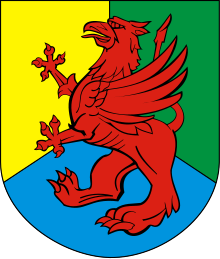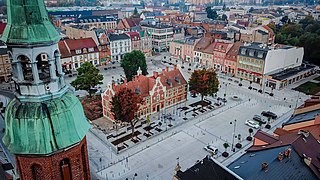
Kociewie is an ethnocultural region in the eastern part of Tuchola Forest, in northern Poland, Pomerania, that is inhabited by the Kociewians. Its cultural capital is Starogard Gdański, the biggest town is Tczew, while other major towns include Świecie, and Pelplin. The region has about 250,000 inhabitants. It has well-developed industry and agriculture. Administratively, it is divided between the Pomeranian and Kuyavian-Pomeranian Voivodeships.

Gniew is a historic town situated on the left bank of the Vistula River, in the Pomeranian Voivodeship, in northern Poland. It has 6,870 inhabitants (2016). It is one of the oldest towns in Eastern Pomerania, and is renowned for its medieval brick gothic Castle, which has become one of the region's most recognizable monuments.

Skarszewy is a small town in Starogard Gdański County, Pomeranian Voivodeship, northern Poland. It is located within the ethnocultural region of Kociewie, 40 kilometres south of Gdańsk. Population: 6 809. In 2005 the town was given the title the Pearl of Pomerania. It is the seat of the urban-rural administrative district Gmina Skarszewy.

The coat of arms of the West Pomeranian Voivodeship, Poland depicts a red griffin with yellow (golden) beak and claws on the white (silver) background. The coat of arms was created by Jerzy Bąk and adopted in 2000.

The coat of arms that serves as the symbol of the city of Szczecin in West Pomeranian Voivodeship, Poland depicts the head of a red griffin with a yellow (golden) beak wearing a yellow (golden) crown, placed on the blue background.

The flag of the West Pomeranian Voivodeship in Poland is a triband rectangle, divided vertically in 3 stripes of white, red, and white colour, and with the coat of arms of the voivodeship in the middle. It was adopted in 2000.

The coat of arms that serves as a symbol of the Subcarpathian Voivodeship, Poland.

The coat of arms of Lubusz Voivodeship, Poland, features an Iberian style escutcheon divided vertically onto two sides, of which, the left side has red background, with left side of a white (silver) eagle, with yellow (golden) crown, legs, a ring on its tail, and a przepaska on its wing, while the right side, has green background with two yellow (golden) six-pointed stars, placed vertically. It was established in 2000.
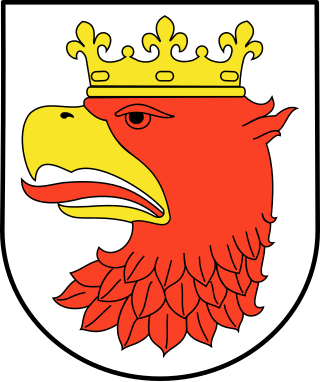
The coat of arms of the town of Police in West Pomeranian Voivodeship, Poland depicts the head of a red griffin with a yellow (golden) beak, and a yellow (golden) crown, place on the white (silver) background.

The coat of arms of the Kuyavian-Pomeranian Voivodeship, Poland, consists of a white (silver) escutcheon, with a half of an eagle facing left, joined with a half of a lion facing right, both animals together wearing a yellow (golden) crown on their joined heads. It had been adopted in 2000.

The flag that serves as the symbol of the historical and geographical region of the Western Pomerania is divided horizontally into two stripes: light blue on the top and white on the bottom. It originated as the flag of the Province of Pomerania, Prussia, used from 1882 to 1935. Since 1996, it is officially recognized as the symbol of the historical region of Western Pomerania within Mecklenburg–Western Pomerania, Germany.

The coat of arms and flag that serve as the symbols of the Police County, in West Pomeranian Voivodeship, Poland were established on 28 June 2000. They were designed by Radosław Gaziński.
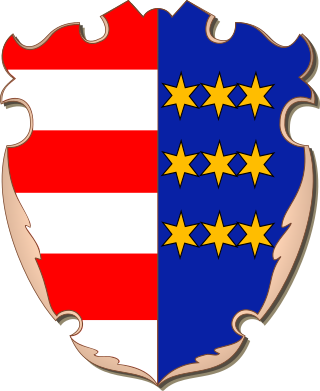
A historical coat of arms symbolized the Sandomierz Land and Sandomierz Voivodeship of the Kingdom of Poland from the 14th to 18th centuries. It was divided into two fields, with the left field consisting of six stripes, alternating either between red and white or red and yellow, and with the right field consisting of several yellow six-pointed stars, whose number varie dbetween seven and nine.

The coat of arms of Sandomierz County is divided vertically into two fields, with the left field consisting of six horizontal stripes, alternating between red and white (silver) colours, and the right field featuring nine yellow (golden) six-armed stars, placed in three horizontal rows. The flag of the county divided into three vertical stripes, of blue, yellow, and blue colour, with the middle stripe being three times, and the coat of arms placed in the centre. The design was based on the historical coat of arms of the Sandomierz Voivodeship, used from 14th to 18th centuries.

The Kocievians, are a Polish ethnocultural group indigenous to the present-day voivodeships of Pomerania and Kuyavia–Pomerania, in north-central Poland. Their settlement area is referred to as Kociewie and they speak the Kociewian dialect of Polish.

The coat of arms that serves as the symbol of Podlaskie Voivodeship, Poland is divided into two horizontal red fields. The top field depicts a white eagle, and a bottom field, a knight in a white (silver) armor, sitting on a white (silver) horse with a blue saddle and shabrack, and yellow (golden) harness, standing on its back hoofs. The knight has a blue shield with a yellow (golden) cross of Lorraine on it, put on his left arm, and hold a sword in his right hand. The current design of the coat of arms was designed by Tadeusz Gajl, and adopted in 2001.

The coat of arms of Pomerania, also known as the Pomeranian Griffin, is the symbol of Pomerania, a historical region on the southern shore of the Baltic Sea in Central Europe, split between Poland and Germany. It depicts a red griffin with yellow (golden) beak and claws, placed within a white (silver) shield. It originates from the late 12th century.
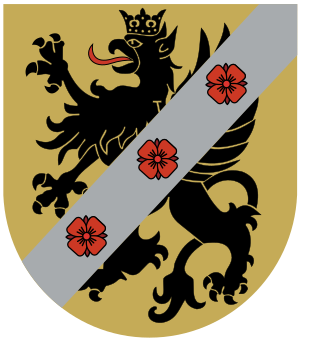
The coat of arms of Wejherowo County, Pomeranian Voivodeship, located in north-central Poland, consists of a black griffin with a black crown on its head, and a grey (silver) band (stripe) running from the top right to the bottom left corner of the shield, with three red roses on it. The design is placed within a light orange (golden) escutcheon (shield). The flag of the county is divided vertically into two stripes of identical width; black on the left, and light orange on the right. In the centre of the left field is placed the coat of arms. Both symbols were established in 2000.

The flag that serves as the symbol of Kociewie, a cultural region in Poland, considering of Starogard, Świecie, and Tczew Counties, is dominated by a yellow isosceles triangle based on the hoist-side pointed toward the fly-side and then divided into two right triangle, a green on a top, and a light blue on the bottom. There is a stylized dark blue cornflower, centetered on the hoist side of the middle triangle. The flag was adopted in 2022.
